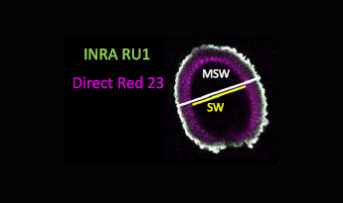Properties and diversity of Arabidopsis thaliana seed seminal mucilage: an example of open science to understand biodiversity
Climate change is having major effects on ecosystems, which will inevitably impact biodiversity. Models predicting these effects require data on how adaptive traits of plants are affected by environmental changes. The ANR CEMMU project aimed to exploit this variability by studying the effect of temperature changes on an adaptive trait of seeds, the production of mucilage, a polysaccharide hydrogel that forms upon imbibition of seed in water.
Various hypotheses have been proposed to explain the adaptive advantage of mucilage production, notably in maintaining seed viability. In Arabidopsis, mucilage is formed by two structurally distinct layers, a water-extractable outer layer and an inner layer adherent to the seed. These structural differences suggest that the two layers perform different functions in seed physiology.
The ANR funded project CEMMU (Consequences of environmental modifications on Arabidopsis seed mucilage properties, diversity and ecophysiological function), coordinated by the Institut Jean-Pierre Bourgin, in collaboration with the UR BIA of Nantes and the UR OPAALE of Rennes, produced datasets with more than 187490 data that have been published in Scientific data edited by the renowned journal Nature. These data, which are available to the scientific community (INRAE Data portal) were generated from 20 natural variants of the model plant Arabidopsis thaliana. The latter is part of a botanical family of which some members produce seeds that, when in contact with water, are surrounded by two layers of hydrogel, the mucilage.
In a previous ANR project (2008-2012), we had discovered that the outer layer of the mucilage naturally exhibits natural variation in its composition and structure, revealing an adaptive role 1,2. In order to assess the impact of climate change on mucilage properties and diversity, the CEMMU project sought to extend our analysis to the characteristics of the inner mucilage layer in order to establish ecophysiological relationships between the production and function of these two layers.
The project generated a wealth of data on the macromolecular and structural characteristics of mucilage as well as the dynamics of seed hydration.
Three datasets were generated that describe the quantity, composition and structure of the internal mucilage as well as the hydration dynamics of 20 natural Arabidopsis variants from various geographical locations in Europe and Central Asia. These variants were selected on the basis of atypical macromolecular characteristics of the outer mucilage 1. The datasets, which cover 33 traits with measures from 4 biological replicates, have been described (see the associated publication 3) and are now available to the scientific community on the INRAE Data portal.They were generated by histological, biochemical and NMR (Nuclear Magnetic Resonance) relaxometry analyses. By sharing and reusing the data, it should be possible to explore different explanations of the adaptive role of seed mucilage and the impact of this variability on their ability to adapt to their natural environment.
A first exploitation of the available data (NMR & chemometrics) has allowed us to make first hypotheses on the impact of the natural variability of the internal mucilage on the hydration rates of the internal tissues of the seeds 4. A statistical analysis of the potential relationships between the different measured characteristics is underway to confirm our hypotheses.
Références:
1 Fabrissin, I. et al. Plant Physiol 181, 1498–1518, https://doi.org/10.1104/pp.19.00763 (2019)
2 Poulain, D. et al. AoB Plants 11, plz031, https://doi.org/10.1093/aobpla/plz031 (2019)
3 Cambert et al. Scientific Data 8 :79, https://doi.org/10.1038/s41597-021-00857-3 (2021)
4 Mas Garcia, S. et al. Talanta, 233 122525, https://doi.org/10.1016/j.talanta.2021.122525 (2021)
Update 16/06/22
Back

Caption: Confocal microscope section through a seed immunolabeled with the antibody (INRA RU1) binding to rhamnogalacturonan 1 with cellulose, co-labeled with Direct Red 23 showing how mucilage and seed width (MSW) or seed width (SW) were measured.
Scientific Highlight of the INRAE TRANSFORM division
"Germination Physiology" team PHYGERM
Associated publication:
Cambert, M, Berger, A., Sallé, C., Esling, S., Charif, D., Cadoret, T., Ralet, M. C., North, H. M., Rondeau-Mouro, C. Datasets of seed mucilage traits for Arabidopsis thaliana natural accessions with atypical outer mucilage Sci. Data. 8 (2021) 79, https://doi.org/10.1038/s41597-021-00857-3
Associated data bases:
dataset 1. Portail Data INRAE https://doi.org/10.15454/1MZ1ZC (2021)
dataset 2. Portail Data INRAE https://doi.org/10.15454/EYABB2 (2021)
dataset 3. Portail Data INRAE https://doi.org/10.15454/LBUN4X (2021)